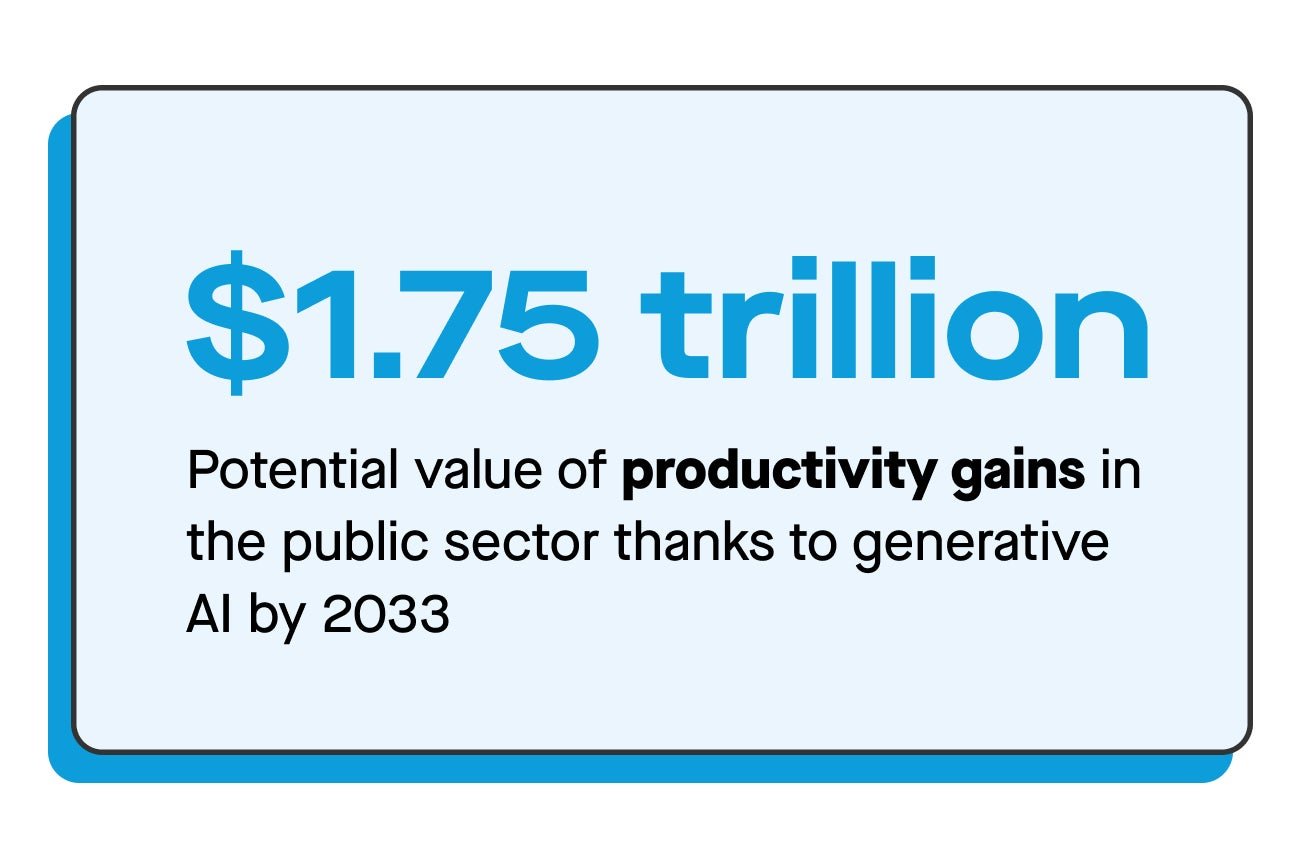Can government work be fast or efficient? An AI engineer transforming the public sector says yes
A Salesforce expert on AI solutions for the public sector sheds light on how data readiness can make government work better for citizens and employees alike

The public sector encompasses everything from local fire departments to federal infrastructure projects — a sprawling network of services that touches the lives of every one of America’s 330 million residents.
Suggested Reading
Due to the massive scale of regional, state, and national agencies and their direct impact on improving wellbeing coast to coast, few areas are as ripe for transformation through artificial intelligence. According to the Boston Consulting Group, productivity gains in the public sector thanks to generative AI could be valued at $1.75 trillion by 2033.
Related Content

With automation and large language models, this revolutionary technology can execute rote tasks, answer commonly asked questions, and introduce efficiencies to free up overburdened employees at agencies like the IRS. Its predictive capabilities can also streamline case routing, shave hours from processing, and lend decision-making assistance to public leaders.
However, the prevailing public sector mindset will need to shift significantly to pave the way for AI adoption. This will require data — acquired through 21st-century technology — obliging the last of the analog industries to undergo a major digital overhaul.
Compared to private sector entities, government institutions are generally slower-moving and more cautious when it comes to new tech like predictive and generative AI and for good reason. Government organizations face unique challenges when it comes to adopting AI — a technology that we are collectively learning so much about, and policy guidelines on the uses of AI for government agencies are in their formative stages. Even in cases where state-level CIOs are eager to explore data readiness, they must first win the trust of constituents and demonstrate a commitment to protect personal data and avoid AI biases.
There are many theories floating around about how best to implement data readiness in the public sector, but there’s no substitute for hands-on experience.

Enter Andy Cather, a Salesforce Distinguished Strategic Solution Engineer for the public sector who’s been in the trenches of helping government agencies implement data readiness for years. We recently caught up with Cather to get his first-hand insights on the opportunities and challenges of getting U.S. institutions up to speed on the world’s most exciting technological innovations.
Q: The public sector, especially if you’re talking about the federal level, operates on a really big scale. Does that make it well-suited to benefit from AI because of the volume of data and the scale of the impact you can have?
A: Historically, governments have been slow to adapt to digital transformation. But in the case of AI, federal, state and local agencies are well-suited because they touch everyone in some way, shape, or form, whether it’s via Social Security, Medicare, or Medicaid.
We know that government processes both internally and externally can be complicated. Using AI in the flow of work for all users can help make complex decisions more efficient. Predictive AI can help determine the likelihood of an application approval or could facilitate early fraud detection. For organizations that are prepared to use AI in a more advanced fashion, generative AI can help agents draft communications or even assist them in real-time decision making processes.
Q: What are the unique challenges that come with AI adoption in the government?
A: Trust and transparency in the sharing of data is a unique challenge to the government. Citizens are right to ask:
What are you doing with my data?And does the AI have any biases around it, any toxicity?
The other side of the coin is policy. In October 2023, the White House issued an executive order on the the safe, secure, and trustworthy development and use of AI, but before that, there weren’t really any policies out there from individual agencies, outside of the National Institute of Standards and Technology doing work around algorithms and putting some information out there.
If you look at Salesforce, as an example of a private sector response to AI, we have an AI policy on how AI can be used and what it cannot be used for, and that’s a publicly available policy we put out there.
More government agencies should follow suit and start to craft their own AI policy, including where they are going to use and not use it.
To me, that’s the biggest challenge. It’s not the lack of data, lack of use cases, or lack of forward-thinking. It’s really around the lack of clear and comprehensive AI policy-making.
Q: On a basic level, what benefits can AI technology bring to public institutions?
A: There are three key AI benefits: more consistent data, better decision support, and better long-term planning.
The first is data consistency.
If AI is in the flow of work with our agents in the Contact Center, it can transcribe the call and standardize data intake. In this case, perhaps the focus could be on creating a consistent subject and description format for each record that’s created in Salesforce. This leads to more consistent data across the entire agency and, downstream, creates the conditions for better reporting and tracking.
As a result, the agency can take data-informed action to improve their operations i.e. adjust agent training, implement smarter call deflection measures, or create more effective case routing rules. Decision support is also beneficial.
We know different people can make different judgments, and there’s nothing wrong with that, but sometimes human bias gets involved. Maybe not everybody has every single piece of information. With AI, we can start to get efficient, effective decisions with a human in the flow of work.
The third benefit is planning. Historically, the government does fiscal year-over-year planning. With AI it can start to get predictive analysis.
Agencies could run scenarios to get ahead of situations, such as:
If the hurricane hits in area X, and there’s X number of small businesses in the area, how many will apply for federal aid? And what is the dollar amount they’re going to apply for based on historical revenue or taxes in that location?
Q: What does data readiness mean to you in the context of the public sector?
A: The first thing we say to customers is:
Go look at your data. Is your data making sense? What data is being used today or not being used? Do you have good data or bad data?
Then we advance with customers to discuss how they could act on their data with AI. In this instance, how they choose to ‘act on their data’ informs how they plan to use the data in applications where AI has a relevant role - be that predictive AI or future-leaning generative AI use cases. We ask customers to consider asking themselves:
What insights do you think your data could provide? Could it suggest any actions if you did some simple analysis? How could the data help you in the flow of work?
Based on those first two levels, then customers can get to level three and that is using the data with AI in the flow of work. The data can be harmonized with a product such as Data Cloud and then used to support prompts with Generative AI or become part of predictive model and AI to support decisions inside of Salesforce.
Q: What do you think of as the stages of AI readiness?
A: Agencies are not going to turn the Titanic on a dime and say: Tomorrow we are going to have AI everywhere, and it’s going to be readily available.
An agency will more likely apply AI to a specific internal process for evaluation. This evaluation will help identify how and where to adopt AI, how to accelerate adoption, and proliferate its usage over time in the flow of work
For example, one division within the Department of Motor Vehicles decided to use a bot instead of phone calls to handle customer questions. Once the bot got a lot of usage, they could start to digest the data it collected.
It helped the customer see where they needed more knowledge articles, where to do more proactive marketing, and where self-serve information could be deployed versus a hands on approach with an agent.
Q: What’s interesting about that example is that the bot was generating efficiency while also creating more human work as opposed to taking away human work.
A: There’s a federal agency that did a lot with digital modernization with their contact center. As an outcome, the duration of the phone calls went up. And at first, the agency was very frustrated.
But we discovered that the duration increased because the human agents were actually handling the calls that they should handle.
The inbound prompt system was deflecting more calls. So the higher priority, higher-need calls were actually getting to the agents where, yes, it took them more time.
Q: Salesforce Einstein — an integrated suite of AI tools tailored for customer relationship management — delivers trillions of predictions a week. Can you share a few examples of the types of predictions?
A: Einstein helps with classification, business insights, and recommendations.
First is case classification. Government agencies get inundated with people requesting something every day, many times via email. Unfortunately, every email that comes in requires somebody to read it, then sort it to the right team, and employees are finite.
Case classification can take all those emails and, using historical closed cases from the customer, auto-triage the email and direct it to the right human resource faster.That’s very efficient government work.
Then Einstein Discovery and Einstein Next Best Actions, which we can refer to as Recommendations can be applied on top of Classifications.
With Einstein Discovery, it augments your business intelligence with statistical modeling and machine learning to identify, surface, and visualize insights into your business data
For example, if someone’s applying for a grant or aid, Discovery could say:
Based on their location and salary, it’s more than likely they will not be approved, but If the customer submitted additional information like X and Y, their likelihood to get approved would go up x percentage points
These types of insights in decision making for government employees can help in streamlining decision making and what needs to be factored in for the “Yes” approval or the “No” denial. In addition, recommendations can be made for the next best action. The next best action could be an automated process to reach out to the customer or actions another employee needs to take on the record.
For example, if I contacted the IRS and asked ...
Help me learn about tax forms or help sessions for my needs. What can I do?
... our Recommendations tool may respond with:
Based on your question and your contact information, we could recommend this knowledge article or webinar about lowering your tax bill.
Q: What’s a small change public sector agencies could make that makes a big difference in data readiness?
A: Talk to your frontline workers about what would help them. Ask them:
If I could change one thing about our internal process, what would it be?
Front line employees are overwhelmed and asked to do more with less. In some instances, their desk stacks of papers and sticky notes everywhere. Email boxes that are overflowing.
I had worked with one federal agency which had hundreds of thousands of unread emails. Employees had gotten to the point where they stopped reading their emails because they were so inundated.
Q: What are you most excited about when you think about transforming the public sector with technology?
A: I’m most excited about AI creating consistency for the agents and the end users and consistency for me as a citizen.
This request is about garnishing a salary.
Then the request can get to an IRS agent who specializes in that. And because of the consistency, that employee can work on this case faster because they understand exactly what it is.
Too many times employees are overwhelmed with data and content. With AI sifting through all the information, summarizing it, and recommending a next step, AI is going to create efficiency for the agent in getting the answer and the customer getting a timely response.
At the cutting edge of customer relationship management, Salesforce aspires to weave AI into the flow of work for our customers, bring the power of AI to bear across enterprise, from marketing to IT.
To learn more about the power of AI and its transformative potential for the public sector, check out Salesforce’s new Book of Best Practices: AI Readiness.
Opinions of the interviewee and/or author are their own and do not necessarily reflect the official position of Salesforce. This post is a sponsored collaboration between Salesforce and Quartz Creative.